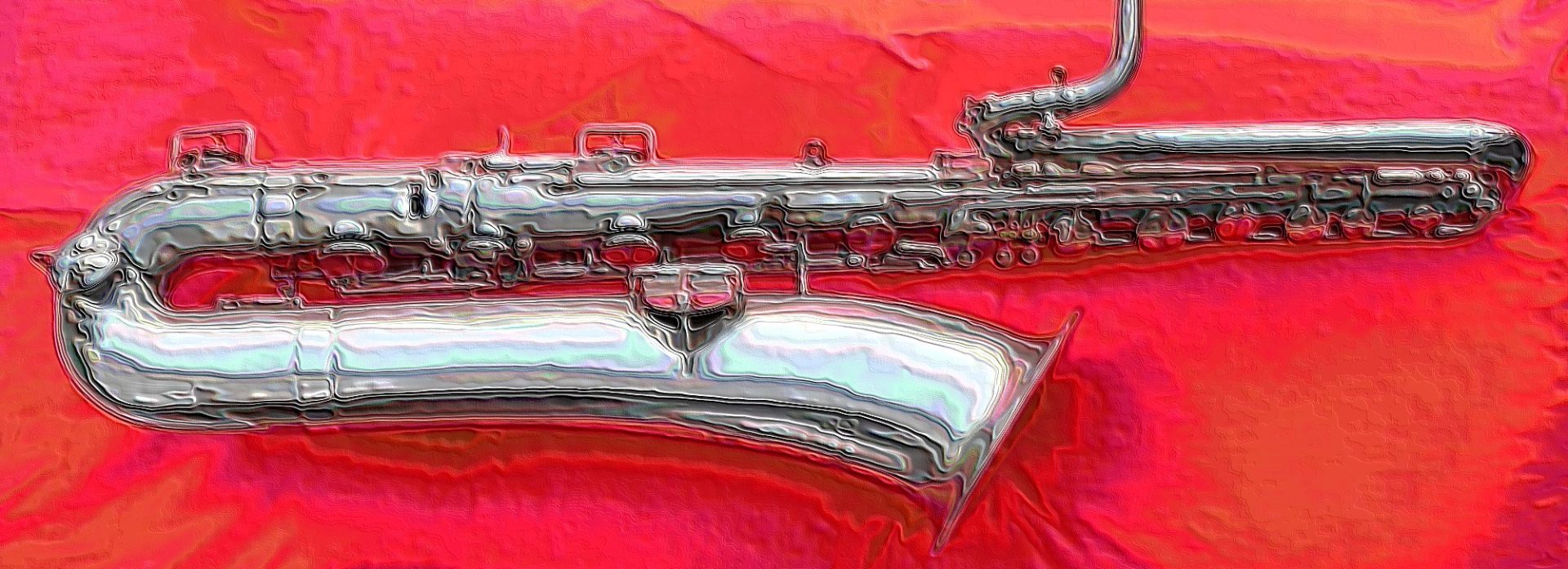Years ago, when I was living in Fredericton, NB, I happened to see the following bass saxophone poster in a catalogue at a framing shop. I have never seen it again. It seems to have only been in the company’s catalogue for a year.
Photography by H. Kahlke
I remember the various Aerobleu posters that were available when I ordered this poster of a bass saxophone player. There was also this other one with a saxophone player that tempted me, but the print shop could only get it in a size that was literally as big as a door. I just didn’t have room for it in my studio.
A few years back I tried to search online for the history of the Aerobleu posters, but didn’t come up with anything. This morning I finally found something that explains the various music posters that are part of the Aerobleu series.
Did you know that these posters were not reproduced from the original vintage ones? There were no vintage posters at all. These were all originally published in the 1990s, as part of Brooks Branch’s experiment to tell a story, market it, and entertain. Here’s a quote from a British website that explains the whole thing:
“Throughout jazz history there have been nightclubs where music and the atmosphere live on to become legendary, like Minton’s in Harlem or Lincoln Gardens in Chicago. In Paris in the late 1940s, it was Aerobleu – notorious for its all-night jam sessions and enigmatic owner Max Morgan …” Or not. Aerobleu was in fact “a unique marketing, storytelling and entertainment experiment” developed by “award-winning creative visionary” Brooks Branch in the late 90?s (Creative Branding Group, retrieved 28/03/2013). The original launch featured a CD of legendary artists who had performed at Aerobleu, compiled and edited by Lees; a portfolio of posters for the legendary appearances of such legends as Miles and Dizzy; the journal of the legendary bar-keep Leslie Ann Nash, and a note-book of her legendary Martini recipes with notes on and quotes from the legendary clientele of the bar; and the legendary lost diary of the legendary owner Max Morgan. Many – unobservant – people were seduced by this “simulacrum with no original” (McMullen, “Identity for Sale”, in Big Ears; Listening for Gender in Jazz Studies, p143), including restaurateur Steve Schussler, the mind behind The Rainforest Cafe, and Hot Dog Hall of Fame; “Seeing an Aerobleu poster in a record shop, he was inspired to create themed restaurants around a recreation of the nightclub. In true Baudrillardian fashion, he seemed even more excited when he found out that the club was faked, and his simulacrum would be based on a pure simulacrum”. Unlike Max Morgan’s DC-3, Schussler’s idea never got off the ground. As Branch’s CBG ‘site describes it “a truly striking case study”.
Source: Peter Harrington London
This bass saxophone poster has been hanging in my studio for over a decade now, and serves as backdrop for my bass saxophone when it’s in its stand. Since the poster is seemingly not available anymore, I thought I’d like to share it with the bass saxophone players who frequent my site. (Hey, and you bari players out there that want to claim it as one of yours, go ahead. 😉 )
BTW, this bass saxophone poster was shot with my new camera: a Lumix GX1 by Panasonic. Yup, I finally made the jump to DSLR.
The night I bought the camera I took some snapshots of things around our house—without first making any customizations to the camera. This poster photo is one of these snapshots.
Given that the lighting in my studio is piss-poor, and I only used the GX1’s built-in flash to light this shot, I think the results are quite respectable. I’m looking forward to seeing what this little camera is capable of doing.
In the summer I had picked up a Lumix LX7 that my favorite shop was clearing out. The LX7 does amazing close ups, so between these 2 cameras, and the new light table we set up in the sunroom, the next 6 months of rain should be creative ones at least.




Funny they should choose a bass sax and 1948 as the year. The instrument was all but irrelevant at that point, except for the great trad work being done by Joe Rushton. Charlie Ventura had not yet attempted bop on it, an experiment that mostly resulted in grotesque showboating.